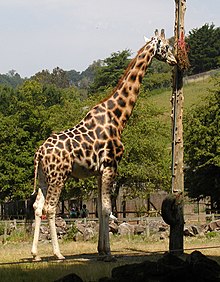The Rothschild Giraffe (Giraffa camelopardalis rothschildi) is one of the most endangered giraffe subspecies with only a few hundred members in the wild. It is named after the famous family of the Tring Museum's founder, Lord Walter Rothschild, and is also known as the Baringo Giraffe, after the Lake Baringo area of Kenya, or as the Ugandan Giraffe. All of those that are living in the wild are in protected areas in Kenya and Uganda.
In 2007, it was proposed that the Rothschild Giraffe is actually a
separate species from other giraffes and not a giraffe subspecies.
While giraffes in general are classified as Least Concern, the Rothschild Giraffe is at particular risk of hybridisation, as the population is so limited in numbers. There are very few locations where the Rothschild Giraffe can be seen in the wild, with notable spots being Lake Nakuru National Park in Kenya and Murchison Falls National Park in northern Uganda.
 Rothschild's Giraffe in Paignton Zoo in England
Rothschild's Giraffe in Paignton Zoo in England
There are various captive breeding programmes in place— notably at the Giraffe Centre in Nairobi, Kenya—which aim to expand the gene pool in the wild population of the Rothschild Giraffe. As of January 2011, more than 450 are kept in ISIS registered zoos (which does not include the Nairobi Giraffe Centre), making it the most commonly kept subspecies of giraffe together with the Reticulated Giraffe. Of those, almost 50 are the result of births within the last year.
Rothschild Giraffes are easily distinguishable from other subspecies. The most obvious sign is in the colouring of the coat, or pelt. Where the Reticulated Giraffe has very clearly defined dark patches with bright whitish channels between them, the Rothschild Giraffe more closely resembles the Masai Giraffe. However, when compared to the Masai Giraffe, the Rothschild subspecies is paler, the orange-brown patches are less jagged and sharp in shape and the connective channel is of a creamier hue compared to that seen on the Reticulated Giraffe. In addition, the Rothschild Giraffe displays no markings on the lower leg, giving the impression that it is wearing white stockings.
Another distinguishing feature of the Rothschild Giraffe, although harder to spot, is the number of horns on the head. This is the only subspecies to be born with five 'horns'. Two of these are 'true' horns at the top of the head, in common with all giraffes. The third 'horn' can often be seen in the centre of the giraffe's forehead and the other two behind each ear. They are also taller than many other subspecies, measuring up to six metres tall (20 ft).
Rothschild Giraffes mate at any time of the year and have a gestation period of 14 to 16 months, with one calf generally being born. They live in small herds, with males and females (and their calves) living separately, only mixing for mating.
Males are larger than females and their two 'true' horns are usually bald from sparring. They also tend to be darker in colour than the females, although this is not a guaranteed sexing indicator.
While giraffes in general are classified as Least Concern, the Rothschild Giraffe is at particular risk of hybridisation, as the population is so limited in numbers. There are very few locations where the Rothschild Giraffe can be seen in the wild, with notable spots being Lake Nakuru National Park in Kenya and Murchison Falls National Park in northern Uganda.

There are various captive breeding programmes in place— notably at the Giraffe Centre in Nairobi, Kenya—which aim to expand the gene pool in the wild population of the Rothschild Giraffe. As of January 2011, more than 450 are kept in ISIS registered zoos (which does not include the Nairobi Giraffe Centre), making it the most commonly kept subspecies of giraffe together with the Reticulated Giraffe. Of those, almost 50 are the result of births within the last year.
Rothschild Giraffes are easily distinguishable from other subspecies. The most obvious sign is in the colouring of the coat, or pelt. Where the Reticulated Giraffe has very clearly defined dark patches with bright whitish channels between them, the Rothschild Giraffe more closely resembles the Masai Giraffe. However, when compared to the Masai Giraffe, the Rothschild subspecies is paler, the orange-brown patches are less jagged and sharp in shape and the connective channel is of a creamier hue compared to that seen on the Reticulated Giraffe. In addition, the Rothschild Giraffe displays no markings on the lower leg, giving the impression that it is wearing white stockings.
Another distinguishing feature of the Rothschild Giraffe, although harder to spot, is the number of horns on the head. This is the only subspecies to be born with five 'horns'. Two of these are 'true' horns at the top of the head, in common with all giraffes. The third 'horn' can often be seen in the centre of the giraffe's forehead and the other two behind each ear. They are also taller than many other subspecies, measuring up to six metres tall (20 ft).
Rothschild Giraffes mate at any time of the year and have a gestation period of 14 to 16 months, with one calf generally being born. They live in small herds, with males and females (and their calves) living separately, only mixing for mating.
Males are larger than females and their two 'true' horns are usually bald from sparring. They also tend to be darker in colour than the females, although this is not a guaranteed sexing indicator.

No comments:
Post a Comment